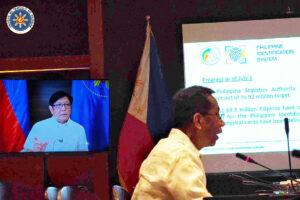PRESIDENT Ferdinand R. Marcos, Jr. has ordered his socioeconomic planning chief to speed up the printing and distribution of more than 50 million national identification cards so these can be used by early 2023.
In a Facebook post on Thursday, Mr. Marcos said the plan to boost the country’s centralized identification system was discussed in his virtual meeting with National Economic and Development Authority (NEDA) Director-General Arsenio M. Balisacan.
Press Secretary Trixie Cruz-Angeles said separately in a news briefing that the system was the “main purpose” of the President’s meeting with Mr. Balisacan.
Ms. Cruz-Angeles said the national ID system is part of the government’s economic recovery plan.
“This is essential especially for the banking system, in setting up small businesses for small entrepreneurs,” she said in mixed English and Filipino. “In the credit system, the ID system is also important.”
A total of 14.3 million Philippine Identification System (PhilSys) cards have been released as of early June, according to the Philippine Statistics Authority.
The former president, Rodrigo R. Duterte, had also ordered to quicken the rollout of PhilSys, which he signed into law in 2018.
The national ID system law institutionalizes a single official identification for all citizens and foreign residents in the country. It incorporates the PhilSys number of every Filipino in all identification systems of government agencies.
The law allows registered individuals to use the ID in renewing passports, licenses, and state clearances, among other state-authorized requirements that need to be presented to avail of certain public and private services.
The government has said the centralized system would improve the delivery of public services.
The law also complements the government’s “financial inclusion” program that seeks to boost people’s access to a wide range of financial services, which are mostly offered by the private sector.
The proportion of Filipino adults with bank accounts reached 53% in the first quarter of 2021 from 29% in 2019. These comprised basic deposit and e-money accounts.
Data from the Philippine central bank showed that deposit accounts rose by 19% to 7.9 million in the last quarter of 2021 from 6.6 million in the same period the previous year.
The Philippine government considers financial inclusion as a key driver of economic recovery towards a post-pandemic world.
The central bank is aiming to transform 50% of the total volume of retail payments into digital and bring 70% of Filipino adults into the banked population by 2023 under its Digital Payments Transformation Roadmap. — Kyle Aristophere T. Atienza

